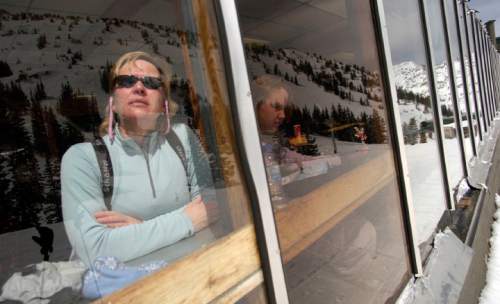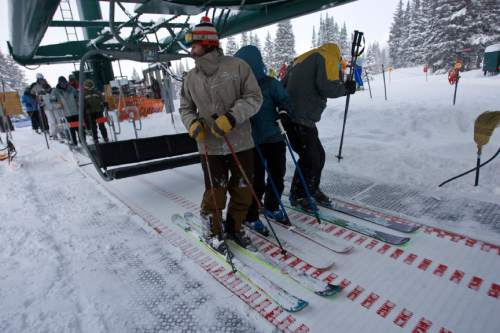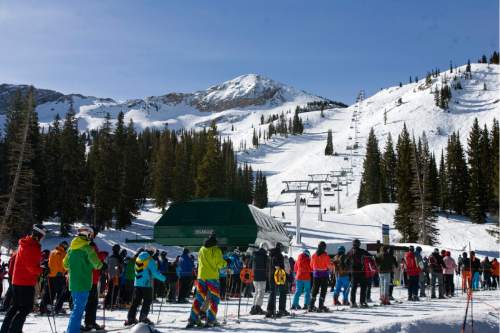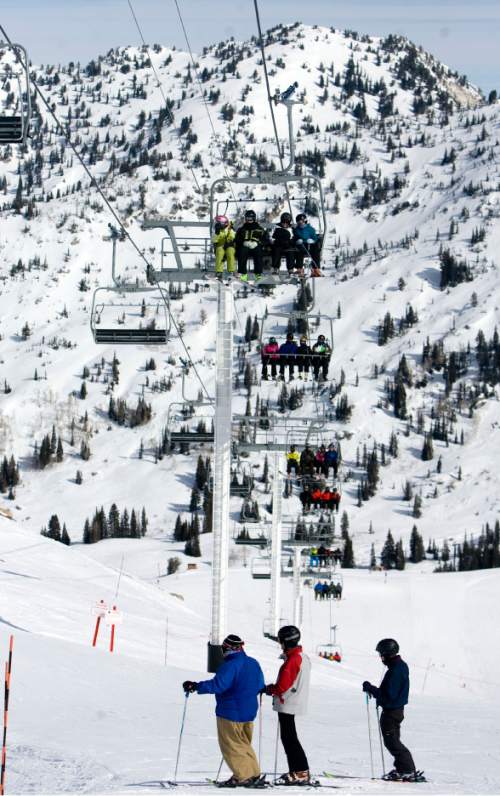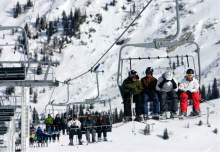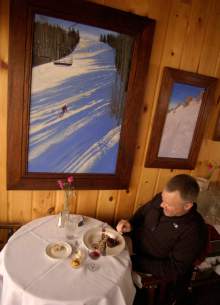This is an archived article that was published on sltrib.com in 2016, and information in the article may be outdated. It is provided only for personal research purposes and may not be reprinted.
Alta Ski Area has grandiose plans for its little bit of heaven at the top of Little Cottonwood Canyon.
They include:
• A tram from Germania Ridge to near the summit of Mount Baldy.
• A new lift, Flora, from Sugarbowl (the bowl directly east of Mount Baldy) to another point on Germania Ridge, eliminating the need for the East Greeley traverse that skiers take from Sugarloaf to Collins lift.
• Replacement of Supreme and Cecret lifts with a single high-speed detachable chair, including an angle station of some sort partway up connecting the two existing lift-line corridors.
• Removal of Albion lift.
• Expansion of Watson's Shelter and Alf's Restaurant.
• Elimination of 50 parking spots in the Wildcat lot to make room for a bus turnaround and drop-offs.
• The addition of 48 parking spots in the Albion lot, which would be expanded with grading, providing a direct connection to the parking area for Snowpine Lodge.
There are a dozen projects overall. Alta submitted them in December to the U.S. Forest Service, which determined they comply with the resort's master plan and permit.
The Forest Service will prepare an environmental assessment of the proposals, said Salt Lake District Ranger Rebecca Hotze, to "analyze and disclose potential impacts. … The analysis will guide our decision on whether or not to approve the projects."
Hotze will accept until May 26 public comment on the scope of issues to be addressed in this analysis.
Alta spokeswoman Connie Marshall is confident that the Forest Service will find the resort's approaches are reasonable.
"This latest set of proposals is based on 10 years of study and conversation," she said. "It reflects Alta being a mature ski area figuring out some of our fine-tuning."
Ski Utah President Nathan Rafferty said Alta's proposals are necessary in a competitive ski market.
Conversely, Carl Fisher of Save Our Canyons is "perplexed … flummoxed about why they would even consider doing some of this."
Nothing bothered him more than the idea of building a small tram capable of moving 150 people per hour to a point below the summit of 11,068-foot Mount Baldy. Its starting point would be on Germania Ridge, just above the upper traverse that skiers take through the woods to the open bowl called Ballroom.
The tram's primary purpose, Alta's proposal said, would be to take ski patrol members up there to do avalanche-control work with hand charges, rather than relying on projectile-based measures to minimize inbound slide dangers.
The lift also could be used by skiers when conditions allow, the proposal added, noting that the snow compaction provided by skiers would serve as "an effective tool in avalanche control."
"This is not a promise to our skiers that this would happen, but a possible secondary benefit," Marshall said, acknowledging that Alta officials are trying to do their best to reduce the visual effects of a 1,900-foot-long lift.
That is a concern for Jen Clancy, executive director of Friends of Alta, a conservation group in the town.
"I would want to make sure that, if the Forest Service were to approve it, that they would be respectful of the ridgeline with the tram cables," she said. Alta "generally has been thoughtful about their lift alignments. There might be other options that would be visually less impactful."
Fisher said it was almost sacrilegious to give people motorized access to the top of Mount Baldy.
"The hike to Baldy has been a rite of passage for a lot of folks," he said, noting that people had to hike hard to earn the right to test their skills and nerves in speedy descents of its narrow chutes.
"Talking with a lot of our members and people who ski Alta regularly, if these projects go forward, it will really hurt the skiing experience that draws people to Alta," Fisher said. "They're falling into the trap of high-speed quads and things like that, which will really change the ski experience, going more toward that consumptive trend of skiing. With this, the powder will be gone in the matter of an hour."
The ski industry changes constantly, and resorts have to keep evolving to keep pace, said Rafferty, whose Ski Utah promotes Alta, 13 other ski resorts and the state's $1.1 billion industry.
"The ski business is not unlike any other business," he said. "You can't rest on your laurels and think people will just keep coming if you don't improve your product, expand your offerings, update what you have available.
"These guys running the resorts are looking way down the road, not just for consumers next year, but five, 10, 20 years down the road," Rafferty added. "We're a huge part of Utah's economy. It only benefits the state when we have a successful winter-sports industry."
Marshall said Alta's proposals would improve its efficient use of the mountain and reduce its footprint.
Most of the resort's lifts are more than 30 years old, she said, and in need of upgrading to the high-speed detachable quads that are now the industry norm.
In replacing them, Alta plans to consolidate the Cecret and Supreme lifts into one. "Starting the combined lift near [an expanded] Alf's Restaurant would greatly improve skier access to the terrain serviced by Supreme," the proposal said.
While taking out Albion would sadden some old-timers who learned to ski off of that lift, it is hardly used these days, Marshall said.
Upgrading nearby Sunnyside lift would help meet skier demand on busy days, the proposal said, adding that the existing triple chair could be replaced by a "chondola — a mix of chairs and gondola or cabriolet cabins."
Wildcat also would be replaced with a quad, and a new lift, called Flora, would be built in Sugarbowl to replace the cat-track trail skiers now use as the upper connection between the Albion and Collins sides of the mountain.
Alta also wants to re-create a small lake near the base of the proposed Flora lift that would hold 8 million gallons of water for making snow. The lake would be 250 feet by 300 feet and 20 feet deep, the proposal said.
Alta also would like to reduce the size of the Wildcat parking lot by 50 spaces to provide more room for a bus turnaround and a drop-off area for visitors.
Most of those spaces would be replaced by doing some earthwork to link the Albion and Snowpine Lodge parking lots.
Fisher was critical of that approach, which he said ran counter to the Mountain Accord planning process' focus on reducing car traffic in the canyons.
Clancy was not troubled by that aspect of the plan, saying the acreage is small, no wetlands would be impacted and "the trade-off is worth it, taking a little bit of public space to move people in cars and on foot better through that area."
All in all, Alta's Marshall said, "we're not trying to be totally innovative in our field, but protecting our experience and our brand."
But it is not likely to take place without a fight.
Said Fisher: "We'll do our best to protect the viewsheds and the experiences that are important to the community and protect these mountains from the greed and shortsightedness of some of these resorts."
Comments?
To see the proposed action, go to http://www.fs.usda.gov/project/?project=48903
Written comments will be accepted until May 26 and can be sent to District Ranger Rebecca Hotze, Salt Lake Ranger Station, 6944 S. 3000 East, Cottonwood Heights, 84121; the office is open weekdays from 8 a.m. to 4:30 p.m.
To comment electronically, send an email to comments-intermtn-uwc@fs.fed.us.




